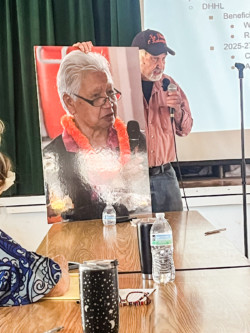Kalaupapa’s Complexities and Future
Although it may be the smallest county in the U.S., there is no lack of activity in Kalaupapa and Kalawao County. While only four patient residents still call Kalaupapa their full-time home, a team of permanent staff along with multiple state and federal agencies direct care, stewardship and more for the community.
The directors of several major organizations including the Dept. of Land and Natural Resources (DLNR), Dept. of Hawaiian Home Lands (DHHL), and the Dept. of Health (DOH) met up on Molokai on Oct. 5 to discuss their current responsibilities in Kalaupapa. While the purpose of the joint meeting was just to explain current roles for these various agencies in Kalaupapa, the impending question of what the future of the community without patients will look like was on the minds of many Molokai residents.
Right now, Kalaupapa is a combination of joint stewardship and land ownership. DOH is responsible for the “care and treatment” of Hansen’s disease patients, explained Kenny Fink, director of DOH for Hawaii.
“It’s been our honor to care for Kalaupapa patients. DOH has had this mission for over a century,” said Fink.
Once the last patient passes away, the DOH will vacate Kalaupapa, handing over their responsibilities to the National Park Service (NPS).
“DOH is working hard to be a good steward and preparing with NPS for a smooth transition once our kuleana there of patient care ends,” said Fink.
Kalaupapa became a federally protected National Historical Park in 1980, at the request of the patients, explained Fink. With a current annual budget of over $15 million, NPS has been responsible for the protection and upkeep of various buildings, archeological sites, water and waste systems, as well as coordinating land and resource stewardship.
And while NPS runs the bulk of duties on the 10,725-acre peninsula, they continue to work in conjunction with various stakeholders.
“It’s complicated,” said Superintendent of Kalaupapa National Historical Park, Nancy Holman. “There’s not one agency that governs Kalaupapa.”
In fact, 87 percent of the land is owned by DLNR, with DHHL as the next biggest landowner. NPS leases land from both departments.
At the meeting, DHHL Director Kali Watson expressed interest in more discussions about the future of DHHL land, which amounts to about 1200 acres currently in Kalauapapa. Specifically, Watson raised the possibility of having homestead leases in the future.
“When you talk about preservation of Kalaupapa by Hawaiians, what better way to do it than to have a permanent presence of Native Hawaiians?” said Watson. “I think that’s something that we should consider…before 1865 you had an existing Hawaiian community that thrived in Kalaupapa.”
Watson specifically mentioned that lineal descents of those who called Kalaupapa home would be the priority.
Keeping the history of Kalaupapa in mind as its governing organizations transition is paramount, explained Mikiala Pescaia, community engagement specialist for Kalauapapa National Historical Park.
“Our kuleana exceeds timeline and boundaries and organizations,” she said. “We need to move forward and collaborate to form the best version of aloha ‘aina that we can…It’s always been a Hawaiian place full of Hawaiians.”
As discussions continue to evolve around this special location, respecting the current patient residents of Kalaupapa continues to be the priority.
“This is Pauline Chow, a resident of Kalaupapa who recently passed away,” said DeGray Vanderbilt, a board member of Ka Ohana O Kalaupapa, which is a patient-formed organization dedicated to creating a monument for those sent to Kalaupapa. Vanderbilt held a large photo portrait of Chow, and lamented the lack of community input on the transition team.
“It could be just a few years before this transition plan has to be in place, yet it sounds like there is still a lot of work,” he said. “But, we have no community organization on the transition team.”
Going forward, County Council Member Keani Rawlins Fernandez suggested a greater accessibility of these agencies to the Molokai community. To this end, she proposed organizing a future community meeting, and inviting the state agencies to participate.












Don't have a Molokai Dispatch ID?
Sign up is easy. Sign up now
You must login to post a comment.
Lost Password